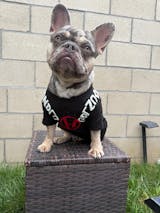Do You Know How to Find Your Dog's Tail Pocket?
Does my dog have a tail pocket? Every dog owner knows that taking care of your dog is absolutely a huge responsibility. For the most part, you are making a lifelong commitment to the health and happiness of man’s best friend. Sometimes, that comes with some extra work we may not anticipate beyond typical long walks, plenty of pets, and general veterinary care. This can be especially true in the case of many specialty breeds with special needs.
While we all love pampering our pooches, sometimes we have to go above and beyond to keep them happy – and healthy – the way they deserve. With that in mind, we’re going to talk about one of the lesser-known health considerations that may require extra maintenance for some breeds – the tail pockets. Before we can jump into the care and maintenance of this anatomical oddity, let’s explain exactly what they are and how to know if your dog has one!

What is a Tail Pocket?
Many dog breeds are covered in wrinkles (adorable, right?), which may include some found in surprising places. The tail pocket is a small indentation- or pocket – located just under the dog’s tail and created by a fold of wrinkly skin. Sometimes, it can be on the top of the tail, or around the tail depending on the dog. Most often, they resemble a dimple on the dog’s butt until you take a closer look.
What dog breeds have tail pockets?
Tail pockets are found in several small dog breeds. The more wrinkled the skin on the dog, the more likely it is to have a pocket.
- American Bulldogs
- English Bulldogs
- French Bulldogs
- Pugs
In most of these breeds, the dog’s tail also plays a factor in whether the pocket is there or not. You will find tail pockets more frequently on dogs with tight, corkscrew tails instead of straighter ones.
How to Find Your Dog’s Tail Pocket (If They Have One):
Not all dogs in the breeds listed above will have a tail pocket! Finding your dog’s tail pocket – if they have one – is easy enough to do. You just run your finger under your dog’s tail to see if they have the extra fold or not.
Puppies are not always born with a tail pocket. In some breeds (like Frenchies), it may not even develop until they are at least six months old or until they are fully grown into their wrinkly glory. Some dogs never develop them at all. Much of it depends on how wrinkly the dog is and the shape of the tail.
What it Means For your Dog’s Health:
However, tail pockets are one of the areas some pet parents may not even be aware of! They aren’t as obvious as the other folds and wrinkles that require special care, but they are just as important to care for. On their own, tail pockets are not a reason to be concerned! They are a perfectly natural occurrence, much the same as the other wrinkles! However, much like those other wrinkles, tail pockets can trap grime, dirt, and other irritants within it. If they aren’t cleaned regularly, they can cause a lot of discomfort – and notable symptoms - to your dog.
At first, you may observe flaky, dry skin around the tail that can advance to red, itchy irritation if left untreated. As the build-up of dirt, grime, and natural oils increase, you may begin to notice an unpleasant smell from the area. Your dog may also drag themselves on the carpet or floor to alleviate the discomfort.
If this is the case, it’s an indicator that your dog’s tail pocket may be in danger of bacterial of yeast infections that can escalate quickly if not taken handled. It’s also uncomfortable and painful for your pup! In the worst-case scenario, this could even lead the necessity for a costly – and uncomfortable – surgery to seal the pocket.
This doesn’t have to be the case! A far easier solution is to learn how to care for the tail pocket properly!
How to Take Care of them:
As with most health-related conditions, an ounce of prevention is worth a pound of cure. This is especially the case when it comes to the care of your dog’s tail pocket. As easy as it is, the hardest part is incorporating tail pocket cleanings into your regular routine. The frequency of cleaning will depend on your dog, so it’s a good idea to keep an eye (and a nose) out for it.
The trick is to do this regularly, so your dog doesn’t suffer from any potential skin irritation or pain.
Here’s how you do it:
- Clean the Area.
Using a damp towel or even a baby wipe, you want to thoroughly clean the area with care. If this is the first time you’ve done it, it may take some additional time. Remember that the tail pocket is sensitive! So be gentle as you clean out the pocket and make sure you get it entirely clean.
- Thoroughly Dry Your Dog’s Tail Pocket
Once you’ve thoroughly cleaned out the tail pocket, you want to make sure it’s completely dry to avoid any further infection. You can use a tissue or dry cloth for this process.
- Spread a Protective Cream – like Wrinkle Paste – On the Area
Because the are can become infected so easily, it’s absolutely important to use preventative creams to make sure the area stays irritant-free. Wrinkle Paste is a thick cream designed to stay between the folds of your dog’s skin. Adding a water-resistant barrier, Wrinkle Paste helps repel fungus, bacteria, and excessive moisture between cleanings. It also helps soothe any hint of infection there. It’s fragrance-free, easy to use, and completely safe for your pup!
The Bottom Line:
If you’re the parent of a wrinkled pup, you know how important it is to be mindful of the wrinkles and folds that add to the personality and adorableness of your favorite four-legged friend. Tail pockets, while a unique part of dog anatomy, are easy to care for if you have the right tools. If you want to make sure your pup has the best preventative care for their most sensitive spots, pick up Squishface Wrinkle Paste today!
Read more about all things tail pockets - from common questions, daily grooming tips, and overall knowledge on a wrinkly pup’s anatomy.







